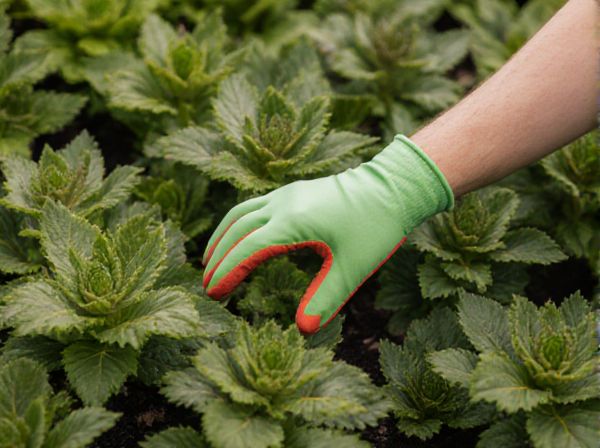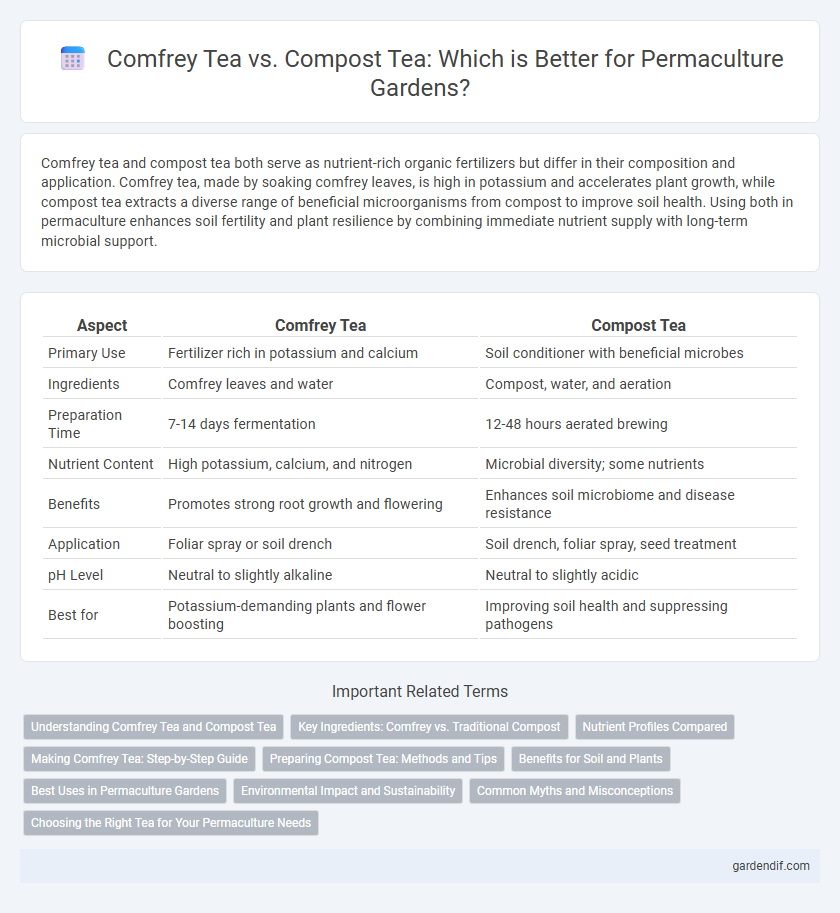
Comfrey Tea vs Compost Tea Illustration
Comfrey tea and compost tea both serve as nutrient-rich organic fertilizers but differ in their composition and application. Comfrey tea, made by soaking comfrey leaves, is high in potassium and accelerates plant growth, while compost tea extracts a diverse range of beneficial microorganisms from compost to improve soil health. Using both in permaculture enhances soil fertility and plant resilience by combining immediate nutrient supply with long-term microbial support.
Table of Comparison
| Aspect | Comfrey Tea | Compost Tea |
|---|---|---|
| Primary Use | Fertilizer rich in potassium and calcium | Soil conditioner with beneficial microbes |
| Ingredients | Comfrey leaves and water | Compost, water, and aeration |
| Preparation Time | 7-14 days fermentation | 12-48 hours aerated brewing |
| Nutrient Content | High potassium, calcium, and nitrogen | Microbial diversity; some nutrients |
| Benefits | Promotes strong root growth and flowering | Enhances soil microbiome and disease resistance |
| Application | Foliar spray or soil drench | Soil drench, foliar spray, seed treatment |
| pH Level | Neutral to slightly alkaline | Neutral to slightly acidic |
| Best for | Potassium-demanding plants and flower boosting | Improving soil health and suppressing pathogens |
Understanding Comfrey Tea and Compost Tea
Comfrey tea is a nutrient-rich liquid fertilizer made by fermenting comfrey leaves, high in potassium, nitrogen, and phosphorus, which promotes vigorous plant growth and improves soil structure. Compost tea, brewed from compost and water, contains diverse beneficial microbes that enhance soil biology, disease suppression, and nutrient availability for plants. Both teas serve distinct roles in permaculture by balancing nutrient supplementation with microbial ecosystem support to optimize plant health and soil fertility.
Key Ingredients: Comfrey vs. Traditional Compost
Comfrey tea is rich in nitrogen, potassium, and essential minerals like calcium and phosphorus due to comfrey leaves' deep root system that extracts nutrients from subsoil. Traditional compost tea contains a diverse array of microbes, humus, and decomposed organic matter that enhances soil microbiology and nutrient cycling. Comfrey tea acts as a potent liquid fertilizer emphasizing nutrient content, while compost tea primarily boosts soil microbial life and organic matter breakdown.
Nutrient Profiles Compared
Comfrey tea provides a concentrated source of potassium, calcium, and trace minerals essential for flowering and fruiting plants, while compost tea delivers a broad spectrum of nutrients including nitrogen, phosphorus, and beneficial microbes that enhance soil health. The high potassium content in comfrey tea supports strong root development and disease resistance, whereas the microbial diversity in compost tea promotes nutrient cycling and improves plant nutrient uptake. Both teas complement each other, with comfrey tea focusing on nutrient density and compost tea enriching soil biology for sustainable permaculture systems.
Making Comfrey Tea: Step-by-Step Guide
Making comfrey tea involves harvesting fresh comfrey leaves, chopping them finely, and immersing them in water to steep for 2 to 4 weeks, allowing beneficial nutrients like potassium, nitrogen, and calcium to leach out. Stirring the mixture every few days accelerates decomposition, turning the leaves into a nutrient-rich liquid fertilizer ideal for promoting plant growth and improving soil health. This fermentation process differentiates comfrey tea from compost tea, which relies on aerated microbial cultures to enhance soil microbiology rather than primarily nutrient extraction.
Preparing Compost Tea: Methods and Tips
Preparing compost tea involves steeping mature compost in aerated water for 24 to 48 hours to extract beneficial microorganisms that enhance soil fertility. Using a fine mesh bag or brewer with an air pump ensures oxygenation, preventing anaerobic conditions that can harm microbial life. Maintaining water temperature between 65-75degF and adding unsulfured molasses as a microbial food source optimizes microbial growth and nutrient availability.
Benefits for Soil and Plants
Comfrey tea delivers a concentrated infusion rich in potassium, nitrogen, and trace minerals that boosts plant growth and enhances soil fertility by accelerating nutrient availability. Compost tea introduces diverse beneficial microorganisms into the soil, improving microbial activity, disease resistance, and nutrient cycling essential for healthy plant development. Both teas enrich soil structure and support plant vitality, with comfrey tea providing immediate nutrient supplementation and compost tea fostering long-term soil ecosystem balance.
Best Uses in Permaculture Gardens
Comfrey tea, rich in potassium, calcium, and trace minerals, accelerates plant growth and enhances flowering, making it ideal for fruiting plants and nutrient-hungry vegetables in permaculture gardens. Compost tea, abundant in beneficial microbes and organic matter, improves soil health, disease resistance, and nutrient cycling, benefiting overall garden ecosystem vitality. Using comfrey tea as a foliar feed and compost tea as a soil drench maximizes their complementary roles in sustainable permaculture management.
Environmental Impact and Sustainability
Comfrey tea, rich in nitrogen, potassium, and micronutrients, enhances soil health by promoting microbial activity while requiring minimal energy input for preparation, making it a sustainable choice with low environmental impact. Compost tea, derived from decomposed organic matter, supports diverse microbial populations that improve nutrient cycling and plant resilience but can involve higher energy costs and risk of pathogen spread if not managed properly. Both teas contribute to eco-friendly gardening practices, with comfrey tea offering quicker nutrient availability and reduced resource consumption compared to the more complex production and application process of compost tea.
Common Myths and Misconceptions
Comfrey tea is often mistaken for a complete fertilizer, but it primarily provides potassium and trace minerals rather than a balanced nutrient profile, unlike compost tea which contains diverse nutrients and beneficial microbes. A common myth claims comfrey tea is a substitute for compost tea; in reality, compost tea enhances soil microbial life, crucial for nutrient cycling and plant health, while comfrey tea mainly boosts foliar feeding. Understanding these distinctions prevents misapplication in permaculture gardens, optimizing plant growth and soil sustainability.
Choosing the Right Tea for Your Permaculture Needs
Comfrey tea is rich in potassium, nitrogen, and phosphorus, making it ideal for boosting plant growth and improving soil fertility in permaculture gardens. Compost tea contains beneficial microbes that enhance soil biodiversity and disease resistance, supporting long-term soil health. Selecting the right tea depends on whether the priority is nutrient supplementation (comfrey tea) or microbial activity enhancement (compost tea) for sustainable permaculture practices.
Comfrey Tea vs Compost Tea Infographic

 gardendif.com
gardendif.com